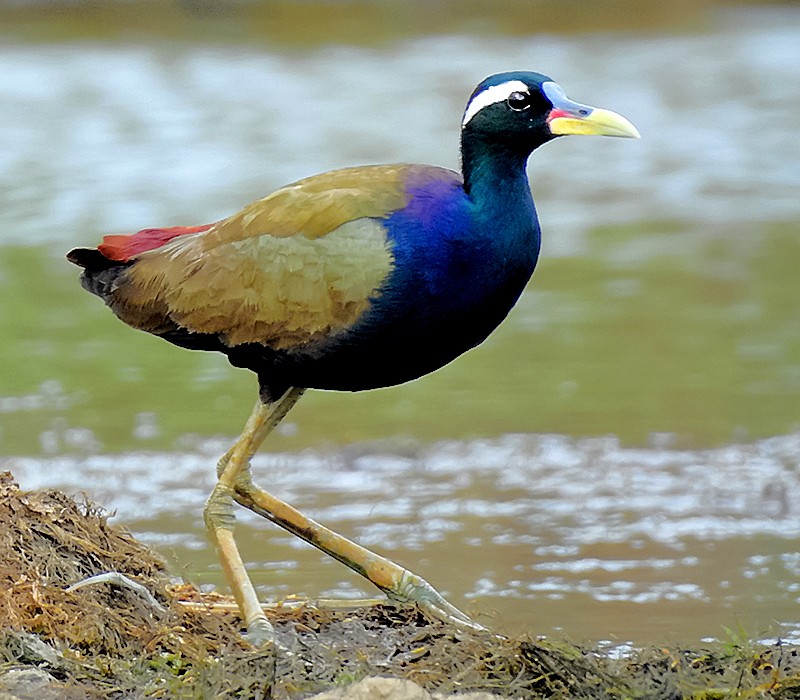Bronze-winged Jacana
A species of Bronze-winged Jacana Scientific name : Metopidius indicus Genus : Bronze-winged Jacana
Bronze-winged Jacana, A species of Bronze-winged Jacana
Botanical name: Metopidius indicus
Genus: Bronze-winged Jacana
Content
Description General Info
 Photo By Shantanu Kuveskar , used under CC-BY-SA-4.0 /Cropped and compressed from original
Photo By Shantanu Kuveskar , used under CC-BY-SA-4.0 /Cropped and compressed from original Description
Bronze-winged jacanas are rail-like, large, short tailed birds that appear dark at a distance except for the supercilium. They are 29 cm (11 in) in length. The sexes are similar but the females are slightly larger than the males. The wings are bronzy brown with a green sheen and have a reduced tubercular carpal spur. The head, neck and breast are black and contrast with the broad white supercilium that runs from over the eye to the back of the neck. The lower back and tail coverts are chestnut. The tail is stubby and reddish brown with black terminal band. The greenish yellow bill has a red-base to the upper mandible. A lappet or frontal shield extends up over the forehead and is reddish purple. The legs are greenish. The toes are long and the straight and the elongated nail on the hind toe is longer than the toe. Downy chicks are light brown with a dark stripe running down the nape. Young birds have brown upperparts, a rufous crown, white underparts, a buff foreneck, an undeveloped frontal shield, and may have a dull supercilium. Adults can be confused at a distance with the common moorhen (which is found in similar habitat) and with the watercock and while young can appear similar to the young of the pheasant-tailed jacana, they lack the black necklace seen in that species. 
Size
31 cm
Colors
Brown
Black
Green
Yellow
Red
White
Blue
Purple
Nest Placement
Ground
Feeding Habits
Bronze-winged Jacana forages alone or with a partner on water plants, eating plant material, insects, and invertebrates plucked from surfaces or picked from the water with their adapted long legs and toes.
Habitat
Bronze-winged Jacana predominantly occupies freshwater wetlands in the Indian Subcontinent and Southeast Asia. It favors habitats teeming with floating and emergent vegetation, such as lakes, swamps, and overgrown paddy fields. These areas are characterized by low elevations and plateau regions, suitable for both seasonal and permanent wetlands. Adaptation to changing water levels is crucial, with bronze-winged Jacana capable of exploiting environments altered by invasive flora.
Dite type
Omnivorous
General Info
Feeding Habits
Bird food type
Behavior
Bronze-winged jacanas are found singly or in pairs foraging on aquatic vegetation. They balance on their long legs and long toes, and feed on plant material (claimed to be purely incidental), insects and other invertebrates picked from the floating vegetation or the water's surface. Call is a wheezy piping seek-seek-seek given mostly in alarm. When threatened they sometimes hide by submerging themselves. The breeding season starts after the rains (June to September in India but occasional breeding in March rains reported in Rajasthan). Males defend territories from other males with open wing and neck stretched displays which can escalate to pecking. The territory maintenance activities are at a maximum from around 9 to 11 AM. The nest is a small platform of stems and leaves of Pistia, Nymphoides, Hydrilla, and Eichhornia placed on a mat of vegetation but eggs may also be laid directly on the leaf of a lotus plant. The usual clutch is four, the eggs are very conical, glossy brown with irregular black zig-zag markings. Incubation and care of the young is entirely left to males. The eggs hatch in 29 days. Predation rates of eggs are high, up to 94% were lost in one study to various predators including birds and turtles. Young chicks may be sheltered between the wings and carried to safety. They become independent of their father when they are about ten weeks old. Nematode parasites, Gongylonema indica and Stellocaronema alii and the feather louse Rallicola indicus have been described from specimens of the bronze-winged jacana. 
Distribution Area
The species is widely distributed across the Indian Subcontinent (but not Sri Lanka or western Pakistan) and Southeast Asia mainly in low elevations. Both this species and the pheasant-tailed jacana can occur in the same habitat. It is sedentary apart from seasonal dispersal in response to drought and rains. They are able to use wetlands covered in introduced weeds such as water hyacinth and make use of the cover provided by Ipomoea aquatica when breeding. 
Species Status
Not globally threatened.
Scientific Classification
Phylum
Chordates Class
Birds Order
Shorebirds Family
Jacanas Genus
Bronze-winged Jacana Species
Bronze-winged Jacana